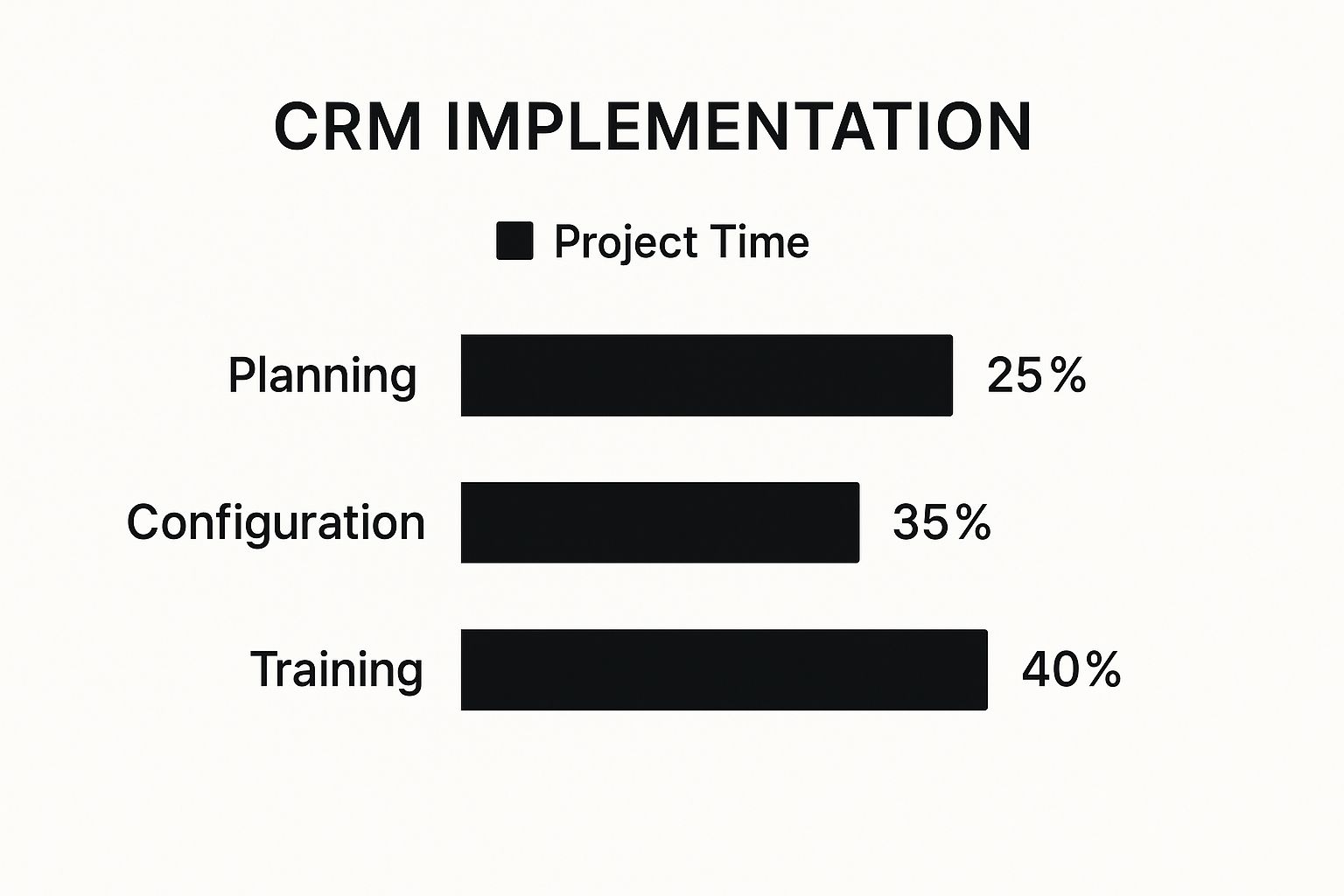How to Implement a CRM System: A Step-by-Step Guide
Why CRM Implementation Transforms Business Results

Before diving into the practicalities of CRM implementation, it's important to understand the reasons behind it. Recognizing the potential of CRM systems is key to motivating your team and getting stakeholders on board. This involves understanding how a CRM can positively affect your profits and drive your business growth. A solid foundation is essential for any successful project. Before implementing a CRM, it's helpful to understand the underlying platform. Check out this resource: WordPress.
Revenue Growth Through Enhanced Sales Processes
A properly implemented CRM system can significantly increase revenue by optimizing the sales process. It empowers your sales team to track leads, manage opportunities, and forecast sales with greater accuracy. This removes the guesswork and promotes data-driven decisions, ultimately resulting in more closed deals and higher revenue.
For instance, a CRM can automate follow-up emails, ensuring no potential customer is overlooked. This targeted approach nurtures prospects and guides them smoothly through the sales funnel.
Improved Customer Retention and Loyalty
Keeping existing customers is often more efficient than acquiring new ones. A CRM system strengthens customer relationships by providing a single platform for all interactions. This gives your team a comprehensive view of each customer, allowing for personalized communication and proactive service.
Furthermore, by tracking customer preferences and purchase history, you can anticipate their needs and offer tailored solutions. This builds loyalty and encourages repeat business, directly contributing to a stronger bottom line.
Enhanced Team Productivity and Collaboration
CRM systems serve as a central hub for all customer-related information, facilitating seamless collaboration across departments. Marketing teams can qualify leads and pass them directly to sales, while customer service teams can access past interactions to resolve issues quickly and effectively.
This streamlined communication minimizes duplicated efforts and allows more time for strategic initiatives, significantly boosting overall team productivity. Implementing a CRM system is essential for business growth, and its adoption has grown considerably. By 2024, 91% of companies with more than 11 employees had integrated a CRM into their operations. This emphasizes the importance of using a CRM for improved customer management and sales optimization.
The CRM market itself has experienced significant growth, expanding from $14 billion in 2010 to $69 billion in 2020, a remarkable increase of 393% over a decade. This exponential growth highlights the potential advantages of CRM implementation in boosting business efficiency and customer engagement. As businesses continue to adopt CRM systems, focusing on training and user adoption is crucial, with 25% of companies identifying these as key challenges. More detailed statistics can be found here: CRM Statistics. These figures showcase the power and possibilities of CRM implementation for businesses of all sizes.
Measurable ROI and Business Transformation
Ultimately, a successful CRM implementation depends on its ability to deliver tangible results. By monitoring key metrics like conversion rates, customer lifetime value, and sales cycle length, you can measure the impact of your CRM investment.
These insights enable you to refine your strategies and optimize your ROI. This data-driven approach transforms your CRM from a simple tool into a powerful driver of business growth and long-term success.
Designing Your CRM Implementation Blueprint

Implementing a CRM successfully isn't a quick process. It takes careful planning and a well-defined strategy. This section guides you through creating a comprehensive blueprint for your CRM implementation, ensuring a smooth transition and maximizing your success. Think of it like constructing a building: a solid foundation is key.
Defining Clear Objectives and Aligning With Business Goals
Start by defining clear, measurable objectives for your CRM implementation. These objectives should directly support your overall business goals, whether that's boosting sales, improving customer retention, or streamlining operations. Focus on the business outcomes you want to achieve, not just technical milestones.
For example, if your goal is to improve customer retention, a related CRM objective might be to reduce customer churn by 15% within the first year. This links the technical implementation to a tangible business result and helps demonstrate the value of the CRM to stakeholders.
Building a Cross-Functional Implementation Team
Create a dedicated team with members from every department that will use the CRM. This cross-functional team should include people from sales, marketing, customer service, and IT. Gathering input from different perspectives is vital. This team becomes your project's core unit, each member bringing their unique skills and insights.
This collaborative approach encourages company-wide acceptance and ensures the CRM meets each department's specific needs. Ultimately, this leads to greater user adoption and a smoother implementation.
Creating a Realistic Timeline and Managing Expectations
Develop a realistic timeline for every implementation phase, keeping in mind your organization's ability to adapt to change. Don't rush the process, as this can introduce errors and frustrate users. A phased approach allows for adjustments along the way.
Divide the implementation into smaller, manageable tasks with clear deadlines. This improves progress tracking and keeps the project on schedule. It also manages expectations and ensures everyone is informed.
Developing Meaningful Success Metrics
Define Key Performance Indicators (KPIs) to gauge the success of your CRM implementation. These metrics should align with your initial objectives and reflect the intended business value. Choose metrics that resonate with leadership and demonstrate a return on investment.
Track metrics like conversion rates, customer lifetime value, and sales cycle length. Analyzing this data reveals the real impact of your CRM on your profits. These insights provide valuable feedback for continuous improvement.
Conducting a Thorough Needs Assessment and Mapping the Customer Journey
Before choosing a CRM, conduct a thorough needs assessment to understand each department's requirements. Map the customer journey to identify touchpoints and ensure your CRM enhances, rather than hinders, customer relationships.
This analysis provides data for selecting a CRM that aligns with your business processes. It also promotes a smoother transition and increases user adoption. Understanding customer interactions helps tailor the implementation to their needs. This customer-centric approach is crucial for success.
To assist in planning your CRM implementation, the following checklist can be a valuable resource:
CRM Implementation Planning Checklist
A comprehensive checklist of tasks and considerations for planning a successful CRM implementation project
| Planning Phase | Key Tasks | Stakeholders Involved | Expected Outcomes |
|---|---|---|---|
| Needs Assessment | Gather requirements from each department, analyze current customer interactions, and document pain points. | Sales, Marketing, Customer Service, IT, Management | Clearly defined CRM requirements and a documented understanding of current processes and challenges. |
| Software Selection | Research CRM vendors, evaluate features and pricing, and conduct demos. | IT, Management, Key users from each department | Selection of a CRM that meets the identified needs and budget. |
| Implementation Planning | Develop a detailed project plan with timelines, milestones, and resource allocation. | Project Manager, IT, Representatives from each department | A comprehensive implementation plan that outlines all necessary steps and responsibilities. |
| Data Migration | Cleanse and migrate existing customer data into the new CRM system. | IT, Data Analysts | Accurate and complete data transfer to the new CRM. |
| Training and User Adoption | Develop training materials and conduct training sessions for all users. | Training team, Key users from each department | Proficient CRM users and high user adoption rates. |
| Go-Live and Support | Launch the CRM system and provide ongoing support to users. | IT, Customer Support | Successful system launch and ongoing user support. |
This checklist provides a structured approach to planning, helping ensure that all crucial aspects are considered. Following these steps greatly increases your chances of a successful CRM implementation.
Effectively implementing a CRM system hinges on meticulous planning. Focusing on these key elements creates a solid implementation blueprint for a successful CRM journey. This detailed approach streamlines implementation and maximizes the return on your CRM investment.
Selecting a CRM That Actually Fits Your Business

Choosing the right CRM is crucial for successful implementation. With the multitude of options available, it's easy to feel overwhelmed. This section provides a clear framework to help you navigate the selection process and pinpoint the ideal CRM for your business. Careful selection is key to maximizing your return on investment.
Cloud-Based vs. On-Premise: Weighing Your Options
One of the first decisions you'll face is choosing between a cloud-based and an on-premise CRM. Cloud-based solutions like Salesforce offer accessibility and flexibility, allowing access from anywhere with an internet connection. They typically require minimal upfront investment and are simpler to maintain. On-premise solutions, like Microsoft Dynamics 365, offer greater control over data security and more extensive customization options. The best choice depends on your specific business needs and priorities.
For growing businesses, the scalability of cloud-based solutions is often a major advantage. This allows them to easily adapt to changing needs without significant IT overhauls. Businesses with strict regulatory requirements, however, might prefer the enhanced security provided by an on-premise solution.
Industry-Specific CRM: Tailored Solutions For Unique Needs
Some industries, such as healthcare or finance, have unique requirements. Industry-specific CRMs cater to these particular needs by offering specialized features and workflows. These tailored solutions can streamline processes and boost efficiency compared to generic CRM platforms.
For example, a CRM designed for healthcare might include features for managing patient records and ensuring compliance with HIPAA regulations. For businesses in less specialized industries, a generic CRM might be a more cost-effective choice, offering sufficient functionality. Choosing the right type of CRM is a critical step in a successful implementation.
Scalability: Planning For Future Growth
As your business expands, your CRM needs will change. Selecting a scalable CRM is crucial for sustained, long-term success. A scalable platform can adapt to increasing data volumes, growing user numbers, and evolving business processes.
Think of your CRM like a plant; you need a pot that allows for growth. Choosing a CRM that lacks scalability is akin to planting a tree in a small pot – it restricts growth and ultimately becomes inadequate. A scalable CRM ensures your system can expand and evolve alongside your business.
Vendor Evaluation: Beyond The Marketing Hype
Don't rely solely on flashy demos and marketing materials. Conduct thorough vendor evaluations that test real-world business scenarios. Assess integration capabilities with your current technology stack, evaluate implementation complexity realistically, and carefully analyze pricing models beyond the advertised rates.
To help you in your decision-making process, the following table compares key features, pricing, and capabilities across popular CRM platforms:
CRM Solution Comparison Matrix
Comparison of key features, pricing, and capabilities across popular CRM platforms to help with decision-making
| CRM Solution | Core Features | Industry Focus | Pricing Model | Implementation Complexity | Integration Capabilities |
|---|---|---|---|---|---|
| Salesforce | Sales force automation, marketing automation, customer service, analytics | Wide range, including sales, marketing, service, and more | Subscription-based | Varies depending on customization | Extensive API and pre-built integrations |
| HubSpot | Marketing automation, sales automation, customer service, CRM | Marketing, sales, and service | Freemium and subscription-based | Relatively easy | Wide range of integrations |
| Zoho CRM | Sales force automation, marketing automation, customer support, analytics | Small to medium-sized businesses | Freemium and subscription-based | Moderate | Good integration options |
| Microsoft Dynamics 365 | Sales, marketing, customer service, field service, finance, operations, commerce | Wide range, including enterprise and industry-specific solutions | Subscription-based | Can be complex | Integrates well with other Microsoft products |
This table provides a framework for evaluating potential CRM vendors, empowering you to make an informed decision. A carefully chosen CRM significantly improves the likelihood of a successful implementation.
CRM Market Growth And Importance
The CRM market is experiencing significant growth, demonstrating the increasing importance of these systems. The market is projected to surpass $100 billion by 2025 and reach $178.7 billion by 2034, growing at a CAGR of 9.8%. CRM adoption is also anticipated to increase from 60% to 75% by 2025. This growth underscores the vital role of CRM in optimizing customer interactions and driving business success. You can find more detailed statistics here: CRM Market Statistics. This expansion further emphasizes the need for businesses to carefully select solutions aligned with their specific needs.
Visualizing CRM Market Growth (2024-2034)
The data chart below visualizes the projected growth of the CRM market from 2024 to 2034. Each bar represents the market size in billions of dollars for each year. The chart clearly illustrates the substantial and consistent growth anticipated in the coming years. The key takeaway is this dramatic increase, highlighting the growing importance of CRM in the modern business landscape.
Infographic placeholder – Bar Chart showcasing CRM Market Growth projections (2024-2034)
By following these guidelines, you can select a CRM that truly fits your business needs, setting the stage for successful implementation and maximized ROI. This strategic approach ensures that your CRM investment contributes to long-term business growth.
Mastering Data Migration Without the Headaches

Data migration is the most crucial step in effectively implementing a CRM system. It's also complex, presenting significant challenges if not handled strategically. This section explores proven methods for a smooth data transition, preserving data integrity while minimizing disruptions. A successful migration creates the foundation for a powerful CRM.
Conducting a Thorough Data Audit: Knowing Your Data
Before migrating, a comprehensive data audit is essential. This involves identifying all data sources, assessing data quality, and finding inconsistencies or errors. It's like spring cleaning; you need to know what you have before organizing it. This prevents bad data from entering your new CRM and ensures a clean start.
Establishing Data Quality Standards: Setting the Bar High
Defining clear data quality standards is paramount. This means establishing rules for data formatting, validation, and completeness. These standards serve as a blueprint, ensuring consistency and accuracy. For example, standardizing phone number formats ensures uniformity and improves reporting. This minimizes future cleanup and maximizes the value of your CRM data.
Staged Migration: Reducing Risk and Ensuring Smooth Transitions
A phased approach to migration is often safest. Migrating in stages lets you test and validate each step, minimizing large-scale errors. It's like building a bridge section by section, ensuring stability at each point. This allows for adjustments, reducing potential business disruptions.
Integration Strategies: Connecting Your Business Systems
Integrating your CRM with other business systems, like marketing automation platforms and accounting software, is key for maximizing effectiveness. Seamless data flow streamlines workflows and provides a holistic business view. Integrating with marketing automation enables targeted campaigns and personalized interactions, enhancing overall efficiency.
Validation Techniques: Catching Problems Early
Implement robust validation techniques to catch and correct errors before they impact users. These techniques can include automated checks for data consistency and manual reviews by specialists. This proactive approach, like quality control in manufacturing, prevents errors from reaching users and ensures accuracy.
Maintaining Data Hygiene: Long-Term Data Integrity
Establishing protocols for ongoing data maintenance is crucial for long-term data integrity. This includes regular data cleansing, updates, and validation. Think of it like maintaining a garden; ongoing care is essential for continued health. This ensures your CRM data remains accurate and valuable, maximizing its potential for insights and growth. Josh Lamb Systems understands data migration's complexities. We help businesses implement strategies for a seamless transition, leveraging their CRM investment's full potential. Contact us today to learn more.
Transforming Reluctant Users Into CRM Champions
Implementing a CRM system like Salesforce is a significant undertaking. Even with meticulous planning, implementations can falter without enthusiastic user adoption. This section explores proven strategies for converting potential resistance into active engagement, turning your team into CRM champions. This focus on user adoption is crucial for realizing the full potential of your CRM investment.
Understanding the "What's In It For Me?"
The key to fostering user adoption lies in clearly articulating the benefits for each role. Creating compelling "what's in it for me" narratives is crucial for motivating individuals. For example, sales teams might appreciate automated lead tracking and opportunity management. Customer service representatives might value a centralized hub for customer information.
By highlighting how the CRM simplifies daily tasks and improves overall performance, you can transform skepticism into enthusiasm.
Identifying and Empowering Internal Champions
Identify influential individuals within each department to act as internal CRM champions. These champions can accelerate adoption through peer influence and provide valuable feedback. Empowering them with specialized training and resources creates a network of advocates.
This grassroots approach fosters organic adoption growth and creates a more sustainable culture of CRM utilization.
Role-Specific Training Focused on Daily Workflows
Develop role-specific training programs focused on practical applications and daily workflows. Training should be tailored to each department's unique needs, demonstrating how the CRM directly improves day-to-day tasks.
For example, sales teams might learn how to track leads and generate reports. Marketing teams might focus on segmenting audiences and automating email campaigns. Emphasizing practical benefits increases perceived value and encourages regular CRM use.
Establishing Adoption Metrics and Tracking Progress
Establish clear adoption metrics to measure implementation effectiveness and track progress. These might include login rates, data entry completion, and feature usage. Regularly monitoring these metrics provides insights into user behavior.
Low login rates might indicate a lack of awareness. Incomplete data entry might suggest a need for more user-friendly forms. Actively tracking these metrics allows you to address barriers and ensure long-term success.
Executive Sponsorship and Ongoing Support
Secure executive sponsorship to demonstrate leadership commitment and provide ongoing support. Executive sponsorship should involve active participation and regular communication. This reinforces the CRM's value.
Establish a sustainable support system to address user challenges. This might include a dedicated help desk or online documentation. Providing readily available support promotes long-term engagement with the CRM. Contact us today to find out how we can support your CRM journey.
Unleashing Advanced CRM Capabilities for Competitive Edge
After successfully implementing your CRM system and becoming comfortable with its core features, it's time to explore its advanced capabilities. This is where you can truly unlock the power of your CRM and gain a significant competitive advantage. This section will explore how to leverage these advanced features for maximum business impact.
AI-Powered Analytics: Predicting Customer Behavior
Many modern CRM systems incorporate Artificial Intelligence (AI). This AI analyzes customer data to predict future behavior. This allows you to anticipate customer needs, personalize interactions, and proactively address potential issues. For example, by analyzing past purchases, AI can suggest relevant products or services, increasing cross-selling and upselling opportunities. AI can also identify at-risk customers, allowing your team to intervene and improve retention rates.
Automation Workflows: Eliminating Repetitive Tasks
Advanced CRM platforms offer robust automation features. These features streamline workflows and eliminate repetitive tasks. This frees up your team to focus on higher-value activities, like building relationships and closing deals. Automating tasks like lead qualification, email follow-ups, and report generation saves valuable time and resources, boosting productivity and allowing for more strategic use of your team's skills.
Mobile Capabilities: Empowering Field Teams
Mobile CRM access empowers your field teams with real-time customer information at their fingertips. This enables informed interactions, improved customer service, and increased sales effectiveness. For instance, a salesperson can access a customer's purchase history and preferences before a meeting, leading to a more personalized and productive discussion.
Strategic Approaches for Introducing Advanced Features
Introducing advanced features requires a strategic approach. Begin by identifying high-impact use cases that demonstrate immediate value. Prioritize features that align with your business objectives and provide a tangible return on investment. This focused approach minimizes disruption and maximizes user adoption.
Measuring the ROI of Enhanced Capabilities
Continuously measuring the Return on Investment (ROI) of advanced CRM capabilities is critical. Tracking key metrics like increased sales, improved customer retention, and enhanced team productivity is crucial. This data-driven approach demonstrates the value of your CRM and justifies further investment in its development. The integration of advanced technologies like generative AI and mobile CRM platforms is significantly changing CRM implementation strategies. Businesses using generative AI in their CRM are 83% more likely to exceed their sales goals and 34% report exceptional customer service. Mobile CRM also significantly improves sales target achievement, with businesses leveraging it being 150% more likely to surpass their targets. Explore this topic further: CRM Statistics and Trends. This highlights the potential of advanced CRM tools to boost both sales and customer satisfaction.
Integration With Complementary Technologies: Creating Powerful Ecosystems
Integrating your CRM with complementary technologies creates a powerful ecosystem. Connecting your CRM with marketing automation platforms, analytics tools, and communication channels creates a seamless flow of information and enhances overall business efficiency. This integration provides your team with a comprehensive view of the customer journey, allowing for more personalized and effective interactions.
From Implementation To Continuous Improvement
Implementing a CRM system isn't the end goal; it's the beginning of an ongoing process. This section explores how to transform your initial CRM implementation into a continuously improving system, maximizing its value over time. This requires a proactive approach, focusing on adaptation and refinement.
Establishing Governance Structures
Top-performing organizations establish clear governance structures for their CRM systems. These structures provide a balance between innovation and stability, defining roles, responsibilities, and decision-making processes related to the CRM. This ensures consistent management and prevents the system from becoming fragmented or unwieldy. A well-defined structure acts as a roadmap, guiding the CRM's evolution and ensuring its long-term success.
Developing KPI Dashboards
Create KPI dashboards that directly link CRM performance to key business outcomes. These dashboards should track metrics aligned with your specific business goals, such as conversion rates, customer lifetime value, and sales cycle length. This provides actionable insights into the CRM's true impact, allowing for data-driven adjustments and continuous improvements. A well-designed dashboard offers a clear, concise view of the CRM's effectiveness.
Creating Feedback Loops
Establish consistent feedback loops to gather valuable insights from both users and customers. Regularly soliciting feedback helps identify areas for improvement within the CRM, ensures the system meets user needs, and enhances overall customer satisfaction. This ongoing dialogue is crucial for continuous improvement and prevents the CRM from becoming stagnant or outdated. Actively seeking feedback fosters a culture of continuous improvement and adaptation.
Post-Implementation Reviews and Enhancement Requests
Conduct thorough post-implementation reviews to assess the effectiveness of the CRM and identify key areas for enhancement. Prioritize enhancement requests based on their potential business impact and strategic value. This ensures that resources are focused on the most valuable improvements, maximizing the return on your CRM investment. Regular reviews and careful prioritization keep the CRM aligned with evolving business needs.
Staying Current With Evolving Capabilities
The CRM landscape is constantly evolving. Stay informed about new features, updates, and best practices within the industry. However, avoid chasing every new feature or trend. Instead, focus on enhancements that directly align with your specific business needs and deliver measurable value. This strategic approach ensures your CRM remains a valuable asset without becoming overly complex or costly to maintain. Staying informed allows you to strategically leverage new CRM capabilities to benefit your organization.
Ready to transform your business with a powerful CRM solution? Josh Lamb Systems offers expert guidance and implementation services, helping you achieve measurable results. We specialize in Salesforce, HubSpot, and ActiveCampaign implementation, tailoring solutions to your unique business needs. Contact Josh Lamb Systems today to learn more and schedule a consultation.
Article created using Outrank


